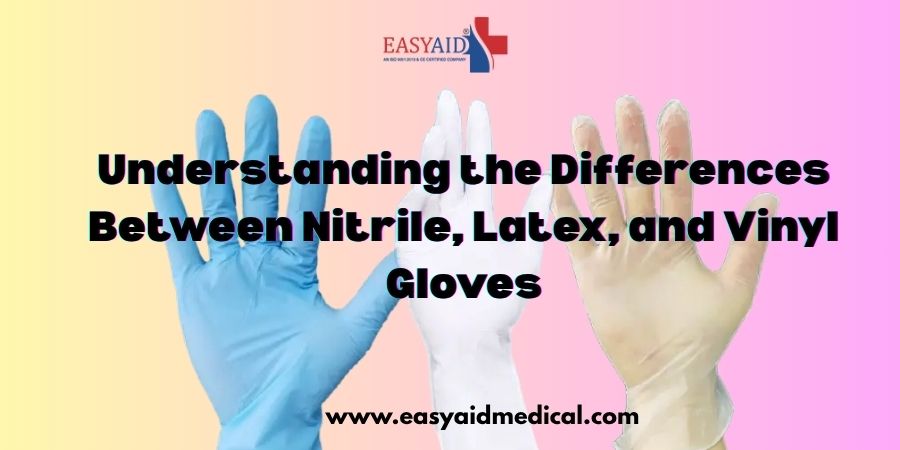Gloves play a major role in the healthcare sector. While it is considered a main element of personal protection equipment (PPE) across many industries, from healthcare to food service, automotive and cosmetics. It functions as a vital barrier, protecting the user and the object they are touching from biological, chemical, and contaminated hazards. The most used varieties of Gloves are – Nitrile, Latex, and Vinyl (PVC) – each possesses unique characteristics that enable them to be applied in different settings. When choosing the best glove by Easyaid Medical for the job and to provide optimal safety, comfort, and value, it is important to understand these differences.
Latex Gloves –
These were undisputed champions of disposable hand protection for decades. Latex gloves are highly elastic, comfortable, and sensitive to touch. They are built of natural rubber latex, which is a milky liquid that is tapped from rubber trees.
Benefits:
Highly elastic and comfortable – They are ideal for fine motor jobs, like intricate medical procedures, surgical use, and laboratory work, due to their high dexterity and flexibility.
Good tactile sensitivity – Wearers can have a very good touch sensitivity due to the thin but tough nature of latex, which is important for use where accuracy is called for.
Barrier protection – They offer good barrier protection against a range of diseases, toxins and body fluids.
Biodegradable – Latex also has an environmental benefit over synthetic alternatives in its natural form.
Ideal for: Dental clinics, surgical environments, selected laboratories. Its usage in healthcare has fallen drastically due to allergic issues.
Also Read- What Brand of Disposable Gloves Do Hospitals Use?
Nitrile Gloves –
As it predominantly targets allergic conditions, Nitrile Gloves, which are produced from synthetic rubber, have become the favorite alternative to latex. It finds a perfect balance between durability, shielding and sensitivity of touch; they have quickly gained the status of being a choice in various sectors.
Benefits:
Allergy-friendly – The most unique feature they possess is that they are latex-free and allergy-friendly, making them safe for individuals who suffer from latex allergies.
Superior Puncture Resistance – Nitrile has a superior level of puncture resistance compared to vinyl and latex. Nitrile tends to tear when punctured instead of stretching, hence making a breach more apparent.
Improved Chemical Resistance – They are suitable for industrial, laboratory and automotive use because they exhibit a high level of resistance to a wide range of chemicals, oils, and solvents.
Fine Tactile Sensitivity – While nitrile has traditionally been less elastic than latex, advances in manufacturing have significantly improved its elasticity and tactile sensitivity to the point where it now equals that of latex in many applications.
Strength and Resistance – Nitrile gloves are known for being tough, offering great resistance to tears and durability when worn.
Ideal for: Tattoo artists, industrial environments, laboratory environments, food handling, healthcare, and any use where superior chemical and puncture resistance without the risk of latex allergy.
Vinyl Gloves –
Polyvinyl chloride PVC is a petroleum-derived plastic used to produce Easyaid Poly PVC Gloves. They are often applied to tasks involving glove changes and in which barrier protection from hazardous material is not the primary concern.
Benefits:
Cost-effective – It is the main advantage that these disposable gloves are cheap, making them ideal for high-volume, low-risk applications. It is free of natural rubber latex, like nitrile gloves; therefore, no allergies to worry.
Suitable for short-term exposure – The vinyl gloves are ideal for short-term, low-stress jobs where lots of stress or extended chemical exposure aren’t required.
Loosely comfortable fit – the gloves fit more comfortably and loosely compared to latex and nitrile gloves, particularly very useful for fast donning and doffing.
Ideal for: Light-duty tasks, short-term use and instances where frequent glove change is needed and there is little probability of exposure to potentially harmful materials.
How to make the right choice?
A thorough risk assessment of the task at hand should always be the deciding factor in choosing which gloves to use.
Consider exposure risks like chemicals, body fluids, infections, or simply dirt in general.
Tactile sensitivity and dexterity are required. Does the task require high levels of touch or fine motor skills?
Do the users or individuals they may be in contact with have known latex allergies?
How many gloves will you be requiring, and how much are you willing to spend?
Consider the impact of synthetic products or biodegradability when you make a purchase?
Conclusion –
You can safely choose between Vinyl Gloves, Latex, and Nitrile by carefully considering these factors, ensuring user comfort, effective protection, and optimum utilization of available resources to your specific needs. While latex was once the most prevalent, the introduction of nitrile and continued use of PVC offer a range of options in the industry.

